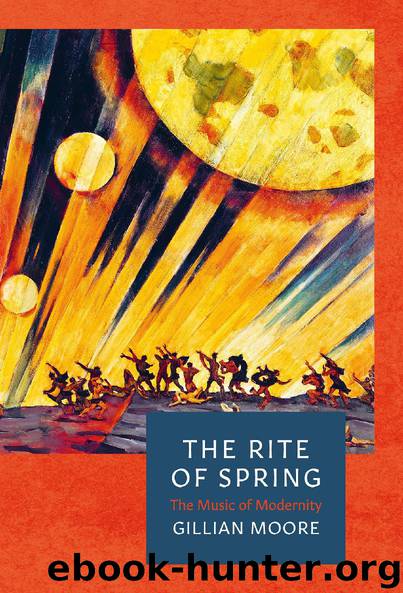The Rite of Spring by Gillian Moore

Author:Gillian Moore [Moore, Gillian]
Language: eng
Format: epub
ISBN: 9781786696816
Publisher: Head of Zeus
* Transliteration of the Russian for ‘One, two, three.’
† Readers might find it useful here to refer to Chapter 6, ‘ The Rite Step by Step: A Listening Guide’.
5
The Music of The Rite of Spring : What Was So New?
Who wrote this fiendish Rite of Spring?
What right had he to write the thing?
Against our helpless ears to fling
Its crash, clash, cling, clang, bing, bang, bing?
And then to call it Rite of Spring?
The season when on joyous wing
The birds melodious carols sing
And harmony’s in every thing!
He who could write The Rite of Spring
If I be right by right should swing!
Anonymous letter to the Boston Herald, 1924 1
Stravinsky’s dream of an ancient ritual to celebrate the coming of spring connected him not just to prehistoric Russia, but to a much more recent tradition. Vivaldi, Beethoven, Schubert, Wagner and many other composers found a seemingly unending source of material in the idea of spring. When Stravinsky was writing The Rite, the living rooms of Europe and America were resounding with Norwegian composer Christian Sinding’s Rustle of Spring, a salon piece popular with amateur pianists because of its relatively undemanding but aurally impressive pyrotechnics. The same year as The Rite of Spring premiere in Paris, Leipzig saw the first performance of On Hearing the First Cuckoo in Spring, a gorgeous, hazy pastoral on the theme by the English-German composer Frederick Delius. But Stravinsky’s spring was a world away from all of this. He was, he said, thinking of ‘the violent Russian spring that seemed to begin in an hour and was like the whole Earth cracking. That was the most wonderful event of every year in my childhood.’ 2 Stravinsky evoked that violent, brutal version of spring in the astonishing novelty of the musical choices he made for The Rite.
There is an intimidating mountain of musicology and analysis written about this half-hour of music: arguably more than about any other musical work. Stravinsky himself deflected discussion about how The Rite of Spring actually works: ‘I was guided by no system whatsoever in Le Sacre du printemps … I am the vessel through which Le Sacre passed.’ 3
This comment by Stravinsky has been much derided. But for the listener, however well informed, there is always a mystery about this music. It will forever be, to some extent, unknowable, and, partly, we want it that way; we want to believe that Stravinsky was simply the vessel for this fully formed miracle that came from somewhere else. But it is, at the same time, irresistible to try to find out as much as possible about how, precisely, the music creates its impact. What was the fuss actually about? Where, specifically, did the innovation lie? Everybody who heard and saw The Rite of Spring in 1913, whether they were the musicians playing it, the dancers dancing it or those who were in the audience at the Théâtre des Champs-Élysées, were struck by the same things: chiefly, the unprecedented harmonic dissonances and the complexity of the rhythm. But there
Download
This site does not store any files on its server. We only index and link to content provided by other sites. Please contact the content providers to delete copyright contents if any and email us, we'll remove relevant links or contents immediately.
| Classical | Country & Folk |
| Heavy Metal | Jazz |
| Pop | Punk |
| Rap & Hip-Hop | Rhythm & Blues |
| Rock |
Cecilia; Or, Memoirs of an Heiress — Volume 3 by Fanny Burney(30934)
Cecilia; Or, Memoirs of an Heiress — Volume 2 by Fanny Burney(30889)
Fanny Burney by Claire Harman(25784)
We're Going to Need More Wine by Gabrielle Union(18072)
Plagued by Fire by Paul Hendrickson(16635)
Cat's cradle by Kurt Vonnegut(13864)
Bombshells: Glamour Girls of a Lifetime by Sullivan Steve(13107)
All the Missing Girls by Megan Miranda(12746)
Leonardo da Vinci by Walter Isaacson(11901)
4 3 2 1: A Novel by Paul Auster(11045)
Adultolescence by Gabbie Hanna(8144)
The remains of the day by Kazuo Ishiguro(7550)
Note to Self by Connor Franta(7024)
Diary of a Player by Brad Paisley(6866)
Giovanni's Room by James Baldwin(5877)
What Does This Button Do? by Bruce Dickinson(5526)
Recovery by Russell Brand(4563)
Born a Crime by Trevor Noah(4510)
The Kite Runner by Khaled Hosseini(4430)
